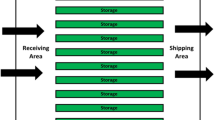Abstract
A mixed-model assembly line requires the solution of a short-term sequencing problem which decides on the succession of different models launched down the line. A famous solution approach stemming from the Toyota Production System is the so-called Level Scheduling, which aims at distributing the part consumption induced by the model sequence evenly over time. Traditional Level Scheduling seeks to closely approximate target demand rates at every production cycle, however, such a strict leveling is only required if parts are directly pulled from a connected feeder line. In real-world assembly lines, parts are predominately delivered in (small) batches at certain points in time. In such a situation, a Just-in-Time supply is already facilitated whenever the cumulative consumption is leveled in accordance with each part’s delivery schedule, while the exact consumption pattern between two delivery points seems irrelevant. The paper on hand provides new Level Scheduling models, proves complexity, presents exact and heuristic solution procedures and shows inferiority of traditional Level Scheduling for such a batched JIT-supply of parts.


Similar content being viewed by others
References
Aarts EHL, Korst JHM, van Laarhoven JM (1997) Simulated Annealing. In: Aarts EHL, Lenstra JK (eds) Local search in combinatorial optimization. Wiley, Chichester, pp 91–120
Aigbedo H (2004) Analysis of parts requirements variance for a JIT supply chain. Int J Prod Res 42:417–430
Bautista J, Companys R, Corominas A (1996) Heuristics and exact algorithms for solving the Monden problem. Eur J Oper Res 88:101–131
Boysen N, Fliedner M, Scholl A (2008) Sequencing mixed-model assembly lines to minimize part inventory cost. OR Spectr 30:611–633
Boysen N, Fliedner M, Scholl A (2009a) Level scheduling under storage constraints. Int J Prod Res 47:2669–2684
Boysen N, Fliedner M, Scholl A (2009b) The product rate variation problem and its relevance in real world mixed-model assembly lines. Eur J Oper Res 197:818–824
Boysen N, Fliedner M, Scholl A, (2009c) Sequencing mixed-model assembly lines: survey, classification and model critique. Eur J Oper Res 192:349–373
Corominas A, Kubiak W, Palli NM (2007) Response time variability. J Sch 10:97–110
Corominas A, Kubiak W, Pastor R (2009) Mathematical programming modeling of the response time variability problem. Eur J Oper Res (to appear)
Dhamala TN, Kubiak W (2005) A brief survey of just-in-time sequencing for mixed-model systems. Int J Oper Res 2:38–47
Fliedner M, Boysen N, Scholl A (2010) Solving symmetric mixed-model multi-level just-in-time scheduling problems. Discrete Appl Math 158:222–231
Garey MR, Johnson DS (1979) Computers and intractability: a guide to the theory of NP-completeness. Freeman, New York
Inman RR, Bulfin RL (1991) Sequencing JIT mixed model assembly lines. Manage Sci 37:901–904
Joo S-H, Wilhelm WE (1993) A review of quantitative approaches in just-in-time manufacturing. Prod Plann Control 4:207–222
Kirkpatrick S, Gelatt CD, Vecchi MP (1983) Optimization by simulated annealing. Science 220:671–680
Kubiak W (1993) Minimizing variation of production rates in just-in-time systems: A survey. Eur J Oper Res 66:259–271
Kubiak W, Sethi SP (1991) A note on “level schedules for mixed-model assembly lines in just-in-time production systems”. Manage Sci 37:121–122
Kubiak W, Steiner G, Yeomans JS (1997) Optimal level schedules for mixed-model, multi-level just-in-time assenbly systems. An Oper Res 69:241–259
Miltenburg J (1989) Level Schedules for mixed-model assembly lines in just-in-time production systems. Manage Sci 35:192–207
Monden Y (1998) Toyota production system: an integrated approach to just-in-time, 3rd edn. Industrial Engineering and Management Press, Norcross
Sabuncuoglu I, Gocgun Y, Erel E (2008) Backtracking and exchange of information: methods to enhance a beam search algorithm for assembly line scheduling. Eur J Oper Res 186:915–930
Solnon C, Cung VD, Nguyen A, Artigues C (2008) The car sequencing problem: overview of the state-of-the art methods and industrial case-study of the ROADEF’2005 challenge problem. Eur J Oper Res 191:912–927
Steiner G., Yeomans JS (1993) Level schedules for mixed-model. just-in-time processes. Manage Sci 39:728–735
Tsai L-H (1995) Mixed-model sequencing to minimize utility work and the risk of conveyor stoppage. Manage Sci 41:485–495
Yavuz M, Akcali E (2007) Production smoothing in just-in-time manufacturing systems: models and solution oaches. Int J Prod Res 45:3579–3597
Zhu J, Ding F-Y (2000) A transformed two-stage method for reducing the part-usage variation and a comparison of the product-level and part-level solutions in sequencing mixed-model assembly lines. Eur J Oper Res 127:203–216
Author information
Authors and Affiliations
Corresponding author
Appendix: NP-hardness proof for LSQ
Appendix: NP-hardness proof for LSQ
We prove NP-hardness for LSQ by a reduction from a specific Partition problem. The Balanced Partition problem is NP-Hard (see Garey and Johnson, 1979) and can be stated as follows:
Balanced partition problem: Given 2n positive integers a i (i = 1, ..., 2n) with \(\sum_{i=1}^{2n} {a_i}=2B\) does there exist a partition of the set {1, 2, ..., 2n } into two sets {A1, A2 } of equal cardinality |A1| = |A2| = n such that \(\sum_{i \in A_1} {a_i}= \sum_{i \in A_2} {a_i} = B?\)
Reduction from balanced partition to LSQ: The idea of the reduction is as follows. We will construct an instance of LSQ with an uneven number of production cycles and force part deliveries to occur exactly at the middle position of the production sequence by using a well-known result of Level Scheduling by Kubiak and Sethi (1991). For this purpose, we introduce two conflicting parts, whose coefficients reflect the integers of Balanced Partition and are adapted in such a way, that whenever the cumulated consumption of one part exceeds its delivery quantity, then the cumulated demand of the other part falls below its delivery quantity, respectively. This will yield the required partition.
Consider an instance of LSQ with parts P = {1, 2, 3, 4}, T = 2n + 1 production cycles and models M = {1, 2, ..., 2n, 2n + 1} with demands \(d_m = 1 \quad \forall m \in M.\) Let the delivery quantities be q 1 = B, q 2 = (n − 1)B, q 3 = 2n + 1 and q 4 = 1 and initial inventories be s 1 = B, s 2 = (n − 1)B, s 3 = n and s 4 = 2n 2 + n. The part consumption for the first 2n models is:
The part coefficients of the last model are a 1,2n+1 = a 2,2n+1 = a 4,2n+1 = 0 and a 3,2n+1 = n + 1. Such an LSQ-instance can be derived from any instance of Balanced Partition polynomially in n, where the first 2n models correspond to the 2n integer values of Balanced Partition.
Notice that due to the definition of parameter values the total numbers of deliveries for the first three parts are equal to \(Y_1=\frac{2B-B}{B}=Y_2=\frac{(2n-2)B-(n-1)B} {(n-1)B}=Y_3=\frac{3n+1-n}{2n+1}=1 ,\) where \(Y_p = \sum_{t=1}^T {y_{pt}}\) and therefore r ′1 = r ′2 = r ′3 = 1/(2n + 1). The initial inventory of Part 4 is sufficient for satisfying total part consumption, so that \(Y_4=\sum_{t=1}^T {y_{t4}}=\frac{2n^2+n-2n^2-n}{1}=0\) and no delivery is required. As a consequence, part 4 does not influence the objective value of solution sequences and we will concentrate on the first three parts in the following.
Kubiak and Sethi (1991) show for the PRV Problem (Miltenburg 1989) that a number of copies of a model family can be evenly distributed in an assembly sequence by computing “ideal due dates” for each copy. This results directly from the fact that the penalty function which measures deviations is nonnegative, convex and takes the value of zero only at zero deviation. It follows that if all copies can be assigned to their respective due date, then the deviation from the target rate is minimal for this model family. The copies of model families directly translate to the number of deliveries per parts. Since we use the same deviation function as in the PRV, we can thus use this insight to derive a sufficient optimality condition for LS Q. Let D * p denote the set of ideal delivery points for part p. This set is computed by
As the first three parts all require exactly one delivery, ideal due dates according to (24) are also equal: \(D^{\ast}_1 = D^{\ast}_2 = D^{\ast}_3 = \left\{n+1 \right\}.\) In other words, the delivery should ideally be scheduled at the middle position of the production sequence for all three parts. Notice that we can use this insight to compute a tight lower bound for such an LSQ-instance which we will denote as \(\hbox{LB}=\sum_{p=1}^{3} 2 \times \sum_{t=1}^n t \times (r_p')^2 = 6 \times \sum_{t=1}^n t \times \left(1/(2n+1)\right)^2.\) Kubiak and Sethi (1991) further show that (for sequences of uneven lengths) any deviation k′ from this middle position leads to additional deviation penalties per part p of ΔZ p = (2k′ − 1) × r ′ p . We can thus conclude that for a solution to such an LS Q-instance, Z = LB holds if and only if y 1,n+1 = y 2,n+1 = y 3,n+1 = 1.
We will show that the decision problem which answers the question of whether there exists a solution to an LSQ-instance of the described form with Z ≤LB is at least as hard as Balanced Partition.
The solution of any YES-instance of Balanced Partition can be transformed to a solution of LSQ by simply arranging the sets A 1 and A 2 and the additional last model as follows:
where the internal order of members in sets A 1 and A 2 can be determined arbitrarily. It can be easily verified that such a solution sequence always allows that delivery points are set to their ideal due date for all relevant parts. As a consequence, the resulting objective value of such a solution will be LB, so that it provides a certificate for a YES-instance of LSQ.
We further established that for any YES-instance of LSQ it has to hold that deliveries occur at the ideal middle position for the first three parts. Any early or late delivery would lead to increased deviation penalties. From restrictions (5)–(10) of the LSQ model we can deduce two necessary conditions which allow such a timely delivery. It has to hold that:
If the first condition is violated, part delivery needs to be scheduled earlier than n + 1, if the second condition is violated, deliveries need to be scheduled later. It immediately follows from (25) that model 2n + 1 cannot be scheduled in the first n slots of the sequence, since a 3,2n+1 = n + 1 > s p = n. Instead, the first n slots of the sequence need to consist of a subset of size n of the first 2n models. Due to the definition of part coefficients, it holds for any subset M′ of M that the cumulated part consumptions of the first two parts are \(\sum_{m \in M^{\prime}} a_{1m} = |M^{\prime}|\times B - \sum_{m \in M^{\prime}} a_{2m} \quad \forall M^{\prime} \subset M.\) As a consequence, it holds for a subset M * of size n, that if \(\sum_{m \in M^{\ast}} a_{1m} < B\) then \(\sum_{m \in M^{\ast}} a_{2m} > (n-1)B.\) In other words, if the total consumption of part 1 up to cycle n is strictly smaller than its initial inventory B, then the total consumption of part 2 violates (25) and vice versa. It follows for a certificate of a YES-instance of LSQ that \(\sum_{t=1}^n\sum_{m \in M}{x_{mt} a_{pm}} = B,\) which directly yields the required balanced partition. We can conclude that an instance of Balanced Partition is a YES-instance, if and only if the corresponding LSQ-instance is a YES-instance, which completes the proof. □
Rights and permissions
About this article
Cite this article
Boysen, N., Fliedner, M. & Scholl, A. Level Scheduling for batched JIT supply. Flex Serv Manuf J 21, 31–50 (2009). https://doi.org/10.1007/s10696-009-9058-z
Published:
Issue Date:
DOI: https://doi.org/10.1007/s10696-009-9058-z




